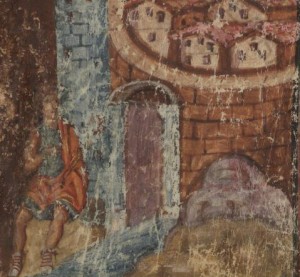 Diverting Latin parlor game: take a very common Latin word (in the DCC Latin Core Vocabulary) that does not occur in Vergil’s Aeneid, and explain its absence. Why would Vergil avoid certain lemmata (dictionary head words) that are frequent in preserved Latin? Sometimes the reason is simply metrical (celeriter, imperator); in other cases, perhaps a word sounded too prosaic (cibus, servus, uxor, interim) for high poetry; sometimes a word just isn’t appropriate for the “prehistoric” period of the epic (provincia, praetor). Sometimes it’s a little hard to figure. Why not sapiens? Why not maiores? Why relinquo but not reliquus? Why vagor but not vagus? Check out the list below and let me know what jumps out at you. The Vergilian data comes from LASLA (no automatic lemmatizers were used, all human inspection), as analyzed by Seth Levin. To check its accuracy, search the DCC version of Frieze’s Vergilian Dictionary, which includes definitions and citations, as well as (LASLA-based) frequency data for individual lemmata. At times there might be some lemmatization issues (for example barbarus came up in the initial list of excluded core words, since Vergil avoids the noun, though he uses the adjective twice. I deleted it from this version). Ok, here’s the list. Enjoy!
Diverting Latin parlor game: take a very common Latin word (in the DCC Latin Core Vocabulary) that does not occur in Vergil’s Aeneid, and explain its absence. Why would Vergil avoid certain lemmata (dictionary head words) that are frequent in preserved Latin? Sometimes the reason is simply metrical (celeriter, imperator); in other cases, perhaps a word sounded too prosaic (cibus, servus, uxor, interim) for high poetry; sometimes a word just isn’t appropriate for the “prehistoric” period of the epic (provincia, praetor). Sometimes it’s a little hard to figure. Why not sapiens? Why not maiores? Why relinquo but not reliquus? Why vagor but not vagus? Check out the list below and let me know what jumps out at you. The Vergilian data comes from LASLA (no automatic lemmatizers were used, all human inspection), as analyzed by Seth Levin. To check its accuracy, search the DCC version of Frieze’s Vergilian Dictionary, which includes definitions and citations, as well as (LASLA-based) frequency data for individual lemmata. At times there might be some lemmatization issues (for example barbarus came up in the initial list of excluded core words, since Vergil avoids the noun, though he uses the adjective twice. I deleted it from this version). Ok, here’s the list. Enjoy!
aegre
arbitror
auctoritas
beneficium
celeriter
censeo
ceterum
cibus
cogito
comparo
consuetudo
damnum
desidero
dignitas
disciplina
dormio
eo (adv)
epistula
existimo
fabula
facinus
familia
fructus
imperator
initium
intellego
interficio
interim
interrogo
itaque
iudico
libido
littera
magnitudo
maiores
materia
memoria
multitudo
mundus (adj)
necessitas
negotium
nolo
oportet
oratio
paene
pecunia
pertineo
plerumque
plerusque
poeta
postea
praetor
privatus
provincia
publicus
quasi
quemadmodum
quidam
reliquus
reverto
sapiens
sapientia
scientia
scribo
servus
solum (adv)
statim
studeo
tamquam
tribunus
vagus
vitium
utilis
utrum
uxor
Image: detail of an illustration of Vergil’s Underworld, from Fulvii Ursini schedae Bibliothecae Vaticanae (Vaticanus Latinus 3225), also known as the Vergilius Vaticanus or “Vatican Vergil” (49r), magnificent illustrated codex written in Italy in rustic capitals at the end of the fourth or the beginning of the fifth century AD. Source: Digital Vatican Library.
 My favourite commentary is R. Deryck Williams’ Aeneid, which dates from 1973 and is now published by the Bristol Classical Press. I think that the main reason that I love it is that it is the work of a man who himself loved Virgil both wisely and well. This love shines on every page. It is a deeply civilized edition, constantly slipping into quotations from English poetry which set the Aeneid in its place near the font of European literature. It is odd that, as reception gains a more and more firm foothold, editors have become increasingly uptight about including literary parallels from the Renaissance and later in their texts. Williams read the Aeneid once a year – each time, he used to say, wondering whether Aeneas would bring himself to abandon Dido – and his understanding of the poem as a whole informs the edition throughout.
My favourite commentary is R. Deryck Williams’ Aeneid, which dates from 1973 and is now published by the Bristol Classical Press. I think that the main reason that I love it is that it is the work of a man who himself loved Virgil both wisely and well. This love shines on every page. It is a deeply civilized edition, constantly slipping into quotations from English poetry which set the Aeneid in its place near the font of European literature. It is odd that, as reception gains a more and more firm foothold, editors have become increasingly uptight about including literary parallels from the Renaissance and later in their texts. Williams read the Aeneid once a year – each time, he used to say, wondering whether Aeneas would bring himself to abandon Dido – and his understanding of the poem as a whole informs the edition throughout.